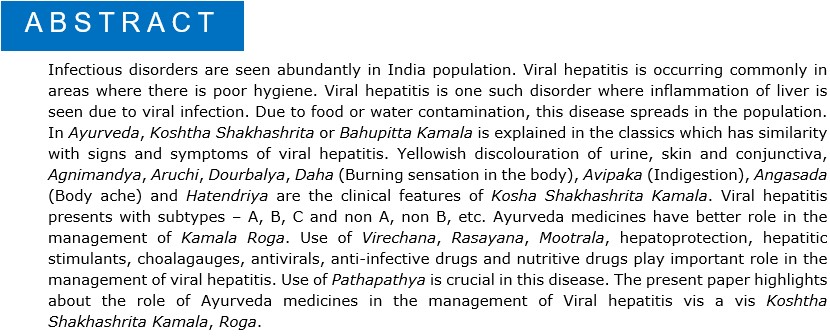Role of Ayurveda medicines in the management of Viral Hepatitis w.s.r. to Koshtha Shakhashrita Kamala
DOI:
https://doi.org/10.21760/jaims.9.5.28Keywords:
Viral hepatitis, Koshtha Shakhashrita Kamala, Anti-viral, hepato protectivesAbstract
Infectious disorders are seen abundantly in India population. Viral hepatitis is occurring commonly in areas where there is poor hygiene. Viral hepatitis is one such disorder where inflammation of liver is seen due to viral infection. Due to food or water contamination, this disease spreads in the population. In Ayurveda, Koshtha Shakhashrita or Bahupitta Kamala is explained in the classics which has similarity with signs and symptoms of viral hepatitis. Yellowish discolouration of urine, skin and conjunctiva, Agnimandya, Aruchi, Dourbalya, Daha (Burning sensation in the body), Avipaka (Indigestion), Angasada (Body ache) and Hatendriya are the clinical features of Kosha Shakhashrita Kamala. Viral hepatitis presents with subtypes – A, B, C and non A, non B, etc. Ayurveda medicines have better role in the management of Kamala Roga. Use of Virechana, Rasayana, Mootrala, hepatoprotection, hepatitic stimulants, choalagauges, antivirals, anti-infective drugs and nutritive drugs play important role in the management of viral hepatitis. Use of Pathapathya is crucial in this disease. The present paper highlights about the role of Ayurveda medicines in the management of Viral hepatitis vis a vis Koshtha Shakhashrita Kamala, Roga.
Downloads
References
Shastry J L N, Dravyaguna vijnana, Choukhambha press, New delhi, Vol 2 2005 PP 650.
Acharya S, Researches in Ayurveda, Shripathi Acharya, Manipal 2010, PP 127.
Acharya S, Ayurveda Vijnana, Shripathi Acharya, Manipal, 2012, PP 140.
Acharya S, Updated Ayurveda, Shripathi Acharya,2011, Manipal, PP 140.
Mishra Siddhinandan Bhaishajya Ratnavali by Kaviraj Govind Das Sen –Kushtharogadhikara 54/ 64 65 Edition Chaukhambha Subharati Prakashana Publication, Varanasi, 2016; 866.
Nair C K N, Mohanan, Medicinal Plants of India, I edition, Nag Publishers, Delhi, 1998, pp 500.
Raghunathan K, Roma Mitra, Pharmacognosy of Indigenous drugs, CCRAS, New Delhi, 2nd edition, 2005, pp 1130.
Warrier P S, Indian Medicinal Plants, Vol I, Arya Vaidya Sala, Kottakal, Orient longman ltd, 1996, pp 420.
K M Nadakarni, Indian Meteria Medica, Vol II, Bombay Popular prakashan Mumbai, PP 968.
Shastry J L N, Dravyaguna vijnana, Choukhambha press ,New Delhi, Vol 32005, PP 170.
Acharya K G, Agraushadhigalu, Shripathi Acharya, Manipal, 2012, PP 160.
Shastry J L N, Dravyaguna vijnana, Choukhambha press, New delhi , Vol 3, 2005, PP. 170.
Haridas Vaidya, Chikitsa Chandrodaya, Haridas and Company Ltd, 11th edition, Madhura, 1992, PP 906.
P V Sharma, Dravya guna Vijnanam, Vol I I, Chaukhambha Bharati Academy 16th edition Varanasi 1995, PP 893.
Ram P Rastogi, Mehrotra B N, Compendium of Indian Medicinal plants, Vol I, CDRI, Lucknow PP 515.
Siddhinandan Mishra, Bhaishajya Ratnavali, Siddhiprada commentary, Choukhambha Sur Bharathi Prakashana, Varanasi 2005, PP 1116.















